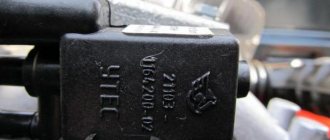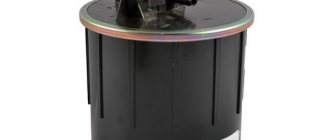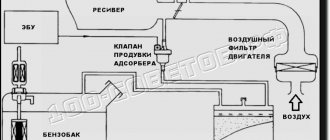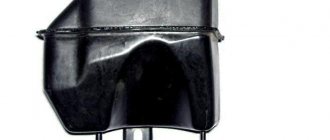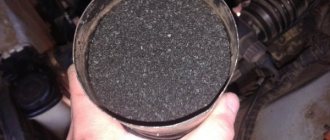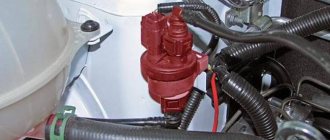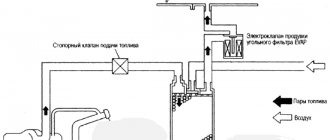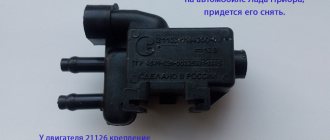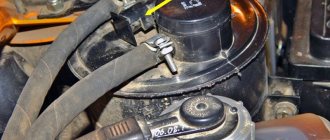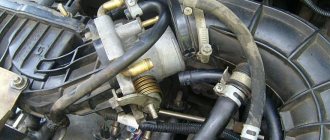January 23, 2017 Lada.Online 99 347 11
The adsorber is designed to capture fuel vapors and prevent them from entering the atmosphere. One of the elements of this system is the adsorber purge valve. Let's consider the main malfunctions of this part, as well as ways to eliminate them.
Purpose and principle of operation of the adsorber
The problem occurs on all trim levels (engines 1.6 and 1.8) and on all bodies (cross, sedan). The user encounters unwanted sounds and does not know how to get rid of it.
The canister is a component of a vapor recovery system called EVAP. It prevents fuel vapors from entering the tank into the atmosphere. Thus, the car is less harmful to the environment. The new product appeared on cars produced according to the Euro-2 standard.
On the plus side, gasoline vapors do not enter the cabin. If you remember old carburetor cars, there was often a smell of fuel in the cabin. Now the carburetor has been completely abandoned and only an injector with a filtration system is installed. Additionally, this provides savings, improves the operation of the internal combustion engine and compensates for the pressure difference in the tank. The absorber also has a number of minor auxiliary functions that depend directly on the design of the EVAP system on a particular vehicle.
Disadvantages - increased complexity of the design and the possibility of its breakdown.
Structurally, the device is very simple and consists of a large plastic cylinder with activated carbon that adsorbs gasoline vapors. Consists of the following components:
- gasoline vapor separator;
- connecting tubes;
- adsorbent part (container with filter substance);
- solenoid and air valves;
- pressure meter.
The principle of operation is very simple. At the top of the tank there is a separator with a gravity sensor. It prevents fuel leakage during accidents to prevent it from igniting.
Absorber valve tube
When the engine starts, the ECU sends a pulse to open the valve, after which purging occurs. This is how fuel vapors mix with air through the throttle. After this, the fuel enters the cylinder, where it is mixed with the bulk of gasoline and burned.
Posts 1 to 25 of 36
1 Topic by Axel 2016-01-09 11:34:58
- Axel
- Participant
- Inactive
- Messages: 973
- Thank you: 139
Topic: Canister valve clatter
Many people have the problem of knocking under the hood, so I decided to create a separate thread on this problem. How can you fight this?
2 Reply from gamer 2016-01-09 11:39:58
- gamer
- Moderator
- Inactive
- Messages: 776
- Thank you: 112
Re: Canister valve clatter
Where exactly is this valve located, is it possible to soundproof it somehow? And can you hear this knock from the cabin? Or does it only bother you when the hood is up?
3 Reply from Fan 2016-01-09 11:53:03
- Fan
- Moderator
- Inactive
- From: Smolensk region
- Messages: 1,017
- Thank you: 204
Re: Canister valve clatter
4 Reply from Lumi 2016-01-09 12:07:48
- Lumi
- Moderator
- Inactive
- From: St. Petersburg
- Messages: 580
- Thank you: 102
Re: Canister valve clatter
Many people have the problem of knocking under the hood, so I decided to create a separate thread on this problem. How can you fight this?
This is an absolutely normal knocking noise and is a consequence of the normal operation of the adsorber valve. So I see no point in fighting him.
Where exactly is this valve located, is it possible to soundproof it somehow? And can you hear this knock from the cabin? Or does it only bother you when the hood is up?
It is located under the hood, to the left of the engine, namely between the engine and the expansion tank, slightly behind. I don't see the point of soundproofing it. For me (Renault Megane III), the clatter of the canister valve can be heard in the cabin only when the engine is turned off and the music is turned off, i.e. in silence and even then, it doesn’t bother you.
Malfunctions of the adsorber and purge valve
If this system breaks down, there are no significant changes in the operation of the vehicle. However, several indirect signs can still be noticed:
- Floating engine speed at idle, the engine may even stall.
- Increased fuel consumption, especially when the engine is warm or increased temperature outside.
- Smell of fuel in the cabin.
- Unstable behavior of the engine while driving mainly consists of a drop in power.
- Error on the dashboard.
- Increased levels of carbon dioxide (CO2).
- Whistling of gases escaping from the fuel tank when it is opened.
- Knock on a cold engine.
System failure is not critical, and movement can continue. However, repairs are still worth making. If we talk about driver comfort, the smell of gasoline, noise, and unstable operation of the power plant negatively affect the driving experience.
Checking the canister purge valve
Before replacing the valve, you can check it. This can be done in the field with a minimum set of necessary tools. You will also need a multimeter to measure the winding resistance.
To check the purge valve, you need to do the following:
- Inspect the pipes in the system, especially near the valve.
- Remove the negative terminal from the car battery so that an error does not occur.
- Dismantle the absorber, disconnect the power connector of the valve itself and remove both hoses from it - inlet and outlet.
- Inject air into the hose holes. This can be done using a car pump or a “pear”. If air does not pass through, it means that its mechanical part is working properly. If it does, the mechanics have failed.
- If you have a lab power supply, apply current to the contacts. This can also be done with a car battery. You should hear a mechanical click made by the relay. If you don’t hear it, the electrical part of the valve is faulty. There should also be sound when there is no power.
- Repeat the “inflating” procedure with the power on. If it is open, then air should flow smoothly. If not, it's broken.
- Take a multimeter, switch it to resistance measurement mode and place the probes on the winding terminals. If the valve is working, the resistance will be about 10-30 ohms. If the resistance is too low, then the coil is broken and there is a short circuit in its winding. If the resistance is huge and is measured in kOhms or mOhms, then there is a break in its winding.
Vacuum adapter tube on Vesta
Depending on the result, decide whether you need to buy a new unit.
Engine Lada Vesta
Products from the Dustershop77 range on the topic of the article:
| Name | Manufacturer | Price | Availability | Add to cart |
| DC1300-20182 | Throttle valve gasket kit K4M/F4R (large+small) ROSTECO | Analogue | 500 / 350 rub. Discount: 250 rub. | >10 |
| DC380-ASAM-30376 | Lower radiator support cushion 7700430992 / 215081131R ASAM-SA 30376 analogue | Analogue | 150 / 100 rub. Discount: 80 rub. | 3 |
| DC1211-8200132254 | Fuel injector for K4M engine original 8200132254 | Original | 2200 / 1900 rub. Discount: 1600 rub. | 4 |
| DC919-226A41772R | Oxygen sensor lambda probe upper Duster, Vesta and other engines. H4M 1.6 226A41772R / 226901841R / 226906393R | Original | 4500 / 4200 rub. Discount: 3900 rub. | 5 |
| DC619-8200048024 | Expansion tank cover original Renault 8200048024 | Original | 700 / 500 rub. Discount: 300 rub. | 2 |
| DC981-FCR210114 | Electric fuel pump FRANCECAR FCR210114 | Analogue | 1500 / 1200 rub. Discount: 1100 rub. | 2 |
| DC1200-BK64105/30598 | Fuel pump ring with gasket | Analogue | 1000 / 700 rub. Discount: 500 rub. | 1 |
| DC1398-30777 | Gasket for fuel pump ring ASAM 30777 | ASAM | 300 / 200 rub. Discount: 150 rub. | 2 |
| DC1746 | Membrane of the crankcase gas recirculation valve Renault Duster, Captur, Terrano, etc. (KVKG membrane F4R 2.0) | Analogue | 2200 / 1700 rub. Discount: 1500 rub. | 3 |
| DC1322-224332428R | Ignition coil 1.6 H4m original 224332428R | Original | 2900 / 2500 rub. Discount: 2100 rub. | 2 |
| LRT-002/6001548140 | Washer reservoir is not original, ANALOGUE 6001548140 | LOGEM | 1000 / 900 rub. Discount: 500 rub. | 1 |
| DC382-ASAM-30494 | Expansion tank ASAM-SA 30494 (7701470460) | Analogue | 1000 / 700 rub. Discount: 600 rub. | 1 |
| DC1740 | Fuel filter for submersible fuel pump Renault Duster, Captur, Terrano, Vesta, etc. 2.0 / 1.6 (LYNX) | Analogue | 2100 / 1800 rub. Discount: 1400 rub. | 1 |
| DC1766 | Throttle valve gasket repair kit K4M/F4R (large+small) Balakovo PTP64 | Analogue | 300 / 200 rub. Discount: 150 rub. | 1 |
| DC1314-135101KT0A | Front crankshaft oil seal H4M original 135101KT0A | Original | 900 / 700 rub. Discount: 550 rub. | 2 |
| DC1320-161191KA1B | Throttle valve H4M original 161191KA1B | Original | 25000 / 18900 rub. Discount: 17900 rub. | 1 |
| 6001548140 | Washer reservoir Renault 6001548140 original | Original | 2000 / 1700 rub. Discount: 1500 rub. | 1 |
| DC918-226A44171R | Oxygen sensor lower lambda probe H4M 1.6 Lambda probe Renault 226A44171R | Original | 11000 / 10500 rub. Discount: 9900 rub. | 1 |
| DC955-150100565R | Oil pump for F4R original 150100565R | Original | 5500 / 4800 rub. Discount: 4400 rub. | 1 |
| DC957-8200665520 | Starter K4M 1.6 original 8200665520 | Original | 12000 / 9900 rub. Discount: 9500 rub. | 1 |
| DC1302-166008992R | Fuel injector for H4M engine original 166008992R | Original | 3500 / 2600 rub. Discount: 2400 rub. | 4 |
| DC1315-122791HC0A | Rear crankshaft oil seal H4M original 122791HC0A | Original | 2000 / 1700 rub. Discount: 1400 rub. | 1 |
| DC1889 | Upper radiator support cushion 215060007R analog | Analogue | 340 / 250 rub. Discount: 200 rub. | 1 |
| DC1682-6001549070 | Fuel vapor absorber original 6001549070 | Original | 4000 / 3200 rub. Discount: 2800 rub. | 2 |
| DC1663-21120370501015 | Ignition coil VAZ 1.6/1.8 21129/21179 original 21120370501015 | Original | 1900 / 1200 rub. Discount: 900 rub. | 4 |
| DC1664-21179113201000 | Fuel injector VAZ 1.8l 2179 original 21179113201000 | Original | 1800 / 1500 rub. Discount: 1300 rub. | 4 |
| DC1644-140328698R | Intake manifold gasket H4M original 140328698R | Original | 700 / 600 rub. Discount: 400 rub. | 4 |
| DC1738 | Fuel pump fuel filter mesh Renault Duster, Captur, Terrano, Vesta, etc. 2.0 / 1.6 (Masuma) | Analogue | 800 / 500 rub. Discount: 350 rub. | 1 |
| DC1837 | Valve cover bushing Vesta, Granta, 2108 (1 piece) | Original | 25 / 15 rub. Discount: 10 rub. | 4 |
| DC1839 | Rings for injectors Vesta, Largus, X-ray, Granta, Kalina (set of 8 pcs.) Rosteco | Analogue | 340 / 250 rub. Discount: 200 rub. | 1 |
| DC1878-21080130704204 | Gasket for pump Largus, Vesta, X-Ray, VAZ-2108-2112 21080130704204 | Original | 50 / 30 rub. Discount: 20 rub. | 1 |
| DC1822-8200291355 | Crankcase gas recirculation valve Renault 8200291355 | Original | 6900 / 6200 rub. Discount: 5900 rub. | 0 |
| DC1321-161757436R | Throttle valve gasket H4M original 161757436R | Original | 800 / 600 rub. Discount: 500 rub. | 0 |
| DC522-233009370R | Starter for F4R engine original art. 233009370R | Original | 14000 / 10600 rub. Discount: 9900 rub. | 0 |
| DC1643-140323253R | Intake manifold gasket H4M original 140323253R | Original | 1900 / 1500 rub. Discount: 1400 rub. | 0 |
| DC1836 | Lower thin injector sealing ring Vesta, Largus, X-ray, Granta, Kalina 21127-1139045R (1 pc.) | Original | 25 / 15 rub. Discount: 10 rub. | 0 |
| DC1838 | Upper thick injector sealing ring Vesta, Largus, X-ray, Granta, Kalina (1 pc.) | Original | 25 / 15 rub. Discount: 10 rub. | 0 |
| DC1002-B208A03276 | Fuel injector for K4M DEKO engine B208A03276 (analogue 8200132254) | Analogue | 2000 / 1500 rub. Discount: 1300 rub. | 0 |
( 2 ratings, average 4.5 out of 5 )
How to disable the adsorber
If the adsorber on the Lada Vesta fails or is no longer needed, it can be removed. In Europe, you can get a good fine for such an upgrade, but in Russia they don’t pay much attention to this. When it is dismantled, fuel consumption increases slightly and the power of the internal combustion engine decreases slightly, but it will be difficult to notice the difference. Remember that you are harming the environment and will breathe gasoline in the car and in the garage.
On the Vesta, the absorber is installed according to the engineers’ plans, so all electronics take into account the fact of its presence. It will be difficult to turn off the system. Only chip tuning will help you get rid of the notification on the on-board computer. To remove the absorber on the Vesta, you first need to make the tank lid leak-proof (drill a hole). Then plug the inlet and outlet hoses. If after this there is a warning on the dashboard, the controller needs to be reflashed.
